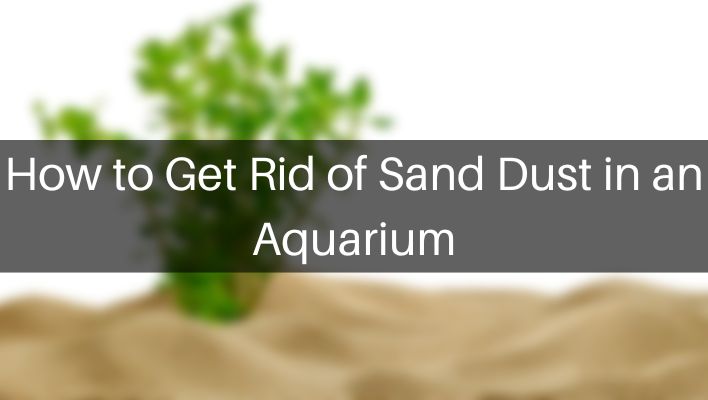
Sand dust is a menace in fish tanks. This dust can clog filters, cloud the water, and ultimately reduce the health and clarity of your aquarium.
It also denies us the luxury of enjoying beautiful aquatic sights. Fortunately, you can take a few steps to ensure your aquarium stays clean and clear.
This guide will provide tips and tricks for how to get rid of sand dust in an aquarium! Stay with us to learn more.

Causes of Sand Dust in Aquarium
When we want to solve anything, we start by understanding its root, what causes it, or where it comes from.
Similarly, we should learn the causes of sand dust in aquariums if we want to maintain a clear sight in the water column of aquaria.
That said, what causes sand dust in aquariums? We have a few answers for you:
Unwashed Sand
Unwashed sand is a ticking time bomb in an aquarium. The worst part is the bomb is mostly detonated immediately after the sand is added to the aquarium.
Sand comes with lots of dust and debris. In some cases, they may contain foreign substances or organisms that negatively affect the aquarium.
Not only is unwashed sand a guarantee of suspended fine particles in the aquarium, but it is also a stamped death warrant for aquatic life.
Staying within the scope of this article, adding unwashed sand into an aquarium is the leading cause of sand dust.
Here’s something to think about: If washed sand can cause sand dust, how much more volume of sand dust can you get from unwashed sand?
Disturbance of the Sand Substrate
Agitation of the sand substrate can cause sand dust to be released into the water, causing cloudiness.
This can occur from vacuuming, cleaning the tank, or moving fish and other inhabitants.
To reduce this, it is essential to be gentle when cleaning the tank or vacuuming the sand substrate and to limit the amount of activity in the tank that can cause agitation.

Inadequate Filtration
If the filtration system in the aquarium is inadequate, it can lead to the buildup of sand dust and other debris in the water, causing it to become cloudy.
This can occur when the filter cannot effectively remove the particles from the water.
Note that filters are a double-edged sword. It can help maintain cloudiness in water if it releases currents strong enough to agitate sand.
Thus, it is about finding the sweet spot between effective sand dust removal and less substrate agitation.
Did you know?
There are many different types of sand available for aquariums, including play sand, aragonite sand, and crushed coral sand.
The type of sand you choose will depend on the species of fish and other life in your aquarium and your personal preferences.
Getting Rid of Sand Dust: Best Tips and Tricks
Since we are clear about the causes of sand dust in the water, we can now talk about what brought you here—getting rid of sand dust!
Here are a few actions you can take to reduce sand dust in aquariums:
Thorough Cleaning
We have discussed how unwashed sand is culprit #1 for sand dust in aquaria. Most fish keepers wash, yet they still see a load of sand dust in the aquarium once added.
Why is this happening? Well, it’s pretty simple. They do clean. However, it’s not as thorough as it should be!
Washing sand thoroughly will reduce most of the sand dust and debris. I have included a short step-by-step process of washing sand.
I use the exact process to prepare and clean sand for aquarium use. Here’s the detailed procedure:
- Fill an enormous container, such as a plastic bin or bucket, with the sand.
- Rinse the sand with water, stirring it gently to remove any loose debris or dust.
- Drain the dirty water and refill the container with clean water.
- Repeat the rinsing process until the water runs clear.
- Allow the sand to settle for a few minutes, then pour off any remaining dirty water.
- Repeat the rinsing and settling process several times to ensure the sand is thoroughly cleaned.
- Leave the sand to dry completely before adding it to the aquarium.
It is vital to wash the sand thoroughly to remove any dust, debris, or other particles that can cloud the water and negatively impact water quality.

Washing the sand also helps to remove any harmful chemicals or pollutants that may be present, ensuring that the sand is safe for use in an aquarium.
It’s also important to note that some sand types may require a longer washing time, and some may release more dust and debris than others.
Be patient and thorough in the washing process to ensure that the sand is as clean as possible before adding it to the aquarium.
Filtration
You should consider upgrading your filtration system if you’re battling sand dust. An efficient and effective filter will remove sand dust immediately—mostly a day after adding sand to the aquarium.
There are two main types of filtration systems commonly used in aquariums: hang-on-back filters and canister filters.
Hang-on-back filters are the more common option. They work by drawing water from the aquarium through a series of filtration media, including mechanical, biological, and chemical filters. T
These filters remove debris, organic waste, and harmful chemicals from the water, helping to maintain good water quality.
Canister filters are larger and more powerful filtration systems that can handle larger aquariums and a higher volume of water.
They work by drawing water from the aquarium, passing it through filtration media, and returning it to the aquarium.
Canister filters offer a higher level of filtration, including mechanical, biological, and chemical filtration.
Upgrading your filtration system can effectively remove sand dust and maintain good water quality in your aquarium.
Consider the size of your aquarium and the fish and other aquatic life types, and choose a filtration system that meets your needs.
It is also essential to clean and maintain your filtration system regularly to ensure that it is functioning effectively.

Vacuum the Top Layer of Sand
During regular water changes, use a gravel vacuum to remove debris, uneaten food, and sand dust from the top layer of sand.
It helps to maintain good water quality and prevent the buildup of harmful waste and chemicals. To vacuum the top layer of sand, follow these steps:
- Fill a bucket with aquarium water.
- Get a gravel vacuum and attach it to a water pump or hose.
- Turn off any equipment, such as heaters and filters that may disturb the sand.
- Slowly lower the gravel vacuum into the sand, taking care not to suck up too much sand or create a sandstorm.
- Move the gravel vacuum back and forth over the top layer of sand, suctioning up any debris and sand dust.
- Dispose of the water and waste in a bucket.
- Repeat the process as necessary until you are satisfied with the cleanliness of the sand.
It’s essential to vacuum the top layer of sand regularly, as part of your routine maintenance, to maintain good water quality and prevent the buildup of sand dust.
Vacuuming the top layer of sand can also help prevent the buildup of toxic gases, such as hydrogen sulfide, which can harm aquatic life.

Partial Water Changes
Water changes are effective in partially reducing a load of sand in aquariums. You take out a chunk of fine dust every time you perform a water change.
Regular partial water changes can help to maintain water quality, remove excess waste, and reduce sand dust. With time, the total volume of sand dust in the aquarium will decrease significantly.
Final Thoughts
Alright, you have successfully read through our guide on getting rid of sand dust in aquariums. We admire your commitment to providing a better environment for fish in aquariums.
Implementing these steps can reduce sand dust in your aquarium and maintain good water quality.
It is essential to monitor the water quality regularly and make adjustments as necessary to ensure the health and well-being of your aquatic life.
What do you think? Feel free to share your thoughts with us in the comment section below!

Jesse is the principal author of this blog. He is an avid fishkeeper with rich experience spanning several years. He is here to share his knowledge and ensure you also have a guiding compass, as he did with his father.